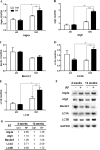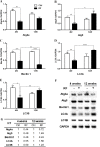Induction of Autophagy in the Striatum and Hypothalamus of Mice after 835 MHz Radiofrequency Exposure
- PMID: 27073885
- PMCID: PMC4830612
- DOI: 10.1371/journal.pone.0153308
Induction of Autophagy in the Striatum and Hypothalamus of Mice after 835 MHz Radiofrequency Exposure
Abstract
The extensive use of wireless mobile phones and associated communication devices has led to increasing public concern about potential biological health-related effects of the exposure to electromagnetic fields (EMFs). EMFs emitted by a mobile phone have been suggested to influence neuronal functions in the brain and affect behavior. However, the affects and phenotype of EMFs exposure are unclear. We applied radiofrequency (RF) of 835 MHz at a specific absorption rate (SAR) of 4.0 W/kg for 5 hours/day for 4 and 12 weeks to clarify the biological effects on mouse brain. Interestingly, microarray data indicated that a variety of autophagic related genes showed fold-change within small range after 835 MHz RF exposure. qRT-PCR revealed significant up-regulation of the autophagic genes Atg5, LC3A and LC3B in the striatum and hypothalamus after a 12-week RF. In parallel, protein expression of LC3B-II was also increased in both brain regions. Autophagosomes were observed in the striatum and hypothalamus of RF-exposed mice, based on neuronal transmission electron microscopy. Taken together, the results indicate that RF exposure of the brain can induce autophagy in neuronal tissues, providing insight into the protective mechanism or adaptation to RF stress.
Conflict of interest statement
Figures




Similar articles
-
Activation of autophagy at cerebral cortex and apoptosis at brainstem are differential responses to 835 MHz RF-EMF exposure.Korean J Physiol Pharmacol. 2017 Mar;21(2):179-188. doi: 10.4196/kjpp.2017.21.2.179. Epub 2017 Feb 21. Korean J Physiol Pharmacol. 2017. PMID: 28280411 Free PMC article.
-
Exposure to 835 MHz radiofrequency electromagnetic field induces autophagy in hippocampus but not in brain stem of mice.Toxicol Ind Health. 2018 Jan;34(1):23-35. doi: 10.1177/0748233717740066. Epub 2017 Nov 22. Toxicol Ind Health. 2018. PMID: 29166827
-
The Protective Effect of Autophagy on DNA Damage in Mouse Spermatocyte-Derived Cells Exposed to 1800 MHz Radiofrequency Electromagnetic Fields.Cell Physiol Biochem. 2018;48(1):29-41. doi: 10.1159/000491660. Epub 2018 Jul 11. Cell Physiol Biochem. 2018. PMID: 29996120
-
Review: Weak radiofrequency radiation exposure from mobile phone radiation on plants.Electromagn Biol Med. 2017;36(2):213-235. doi: 10.1080/15368378.2016.1220389. Epub 2016 Sep 20. Electromagn Biol Med. 2017. PMID: 27650031 Review.
-
Biological effects from electromagnetic field exposure and public exposure standards.Biomed Pharmacother. 2008 Feb;62(2):104-9. doi: 10.1016/j.biopha.2007.12.004. Epub 2007 Dec 31. Biomed Pharmacother. 2008. PMID: 18242044 Review.
Cited by
-
Activation of autophagy at cerebral cortex and apoptosis at brainstem are differential responses to 835 MHz RF-EMF exposure.Korean J Physiol Pharmacol. 2017 Mar;21(2):179-188. doi: 10.4196/kjpp.2017.21.2.179. Epub 2017 Feb 21. Korean J Physiol Pharmacol. 2017. PMID: 28280411 Free PMC article.
-
Exposure to 835 MHz RF-EMF decreases the expression of calcium channels, inhibits apoptosis, but induces autophagy in the mouse hippocampus.Korean J Physiol Pharmacol. 2018 May;22(3):277-289. doi: 10.4196/kjpp.2018.22.3.277. Epub 2018 Apr 25. Korean J Physiol Pharmacol. 2018. PMID: 29719450 Free PMC article.
-
Long-term exposure to 835 MHz RF-EMF induces hyperactivity, autophagy and demyelination in the cortical neurons of mice.Sci Rep. 2017 Jan 20;7:41129. doi: 10.1038/srep41129. Sci Rep. 2017. PMID: 28106136 Free PMC article.
-
Possible Effects of Radiofrequency Electromagnetic Field Exposure on Central Nerve System.Biomol Ther (Seoul). 2019 May 1;27(3):265-275. doi: 10.4062/biomolther.2018.152. Biomol Ther (Seoul). 2019. PMID: 30481957 Free PMC article. Review.
-
Decreased dopamine in striatum and difficult locomotor recovery from MPTP insult after exposure to radiofrequency electromagnetic fields.Sci Rep. 2019 Feb 4;9(1):1201. doi: 10.1038/s41598-018-37874-z. Sci Rep. 2019. PMID: 30718744 Free PMC article.
References
-
- Dubreuil D, Jay T, Edeline J. Does head-only exposure to GSM-900 electromagnetic fields affect. Behav Brain Res. 2002;129:203–10. - PubMed
-
- Leszczynski D, Joenväärä S, Reivinen J, Kuokka R. Non-thermal activation of the hsp27/p38MAPK stress pathway by mobile phone radiation in human endothelial cells: Molecular mechanism for cancer- and blood-brain barrier-related effects. Differentiation. 2002;70(2–3):120–9. . - PubMed
-
- Nittby H, Brun A, Eberhardt J, Malmgren L, Persson BR, Salford LG. Increased blood-brain barrier permeability in mammalian brain 7 days after exposure to the radiation from a GSM-900 mobile phone. Pathophysiology: the official journal of the International Society for Pathophysiology / ISP. 2009;16(2–3):103–12. 10.1016/j.pathophys.2009.01.001 . - DOI - PubMed
Publication types
MeSH terms
LinkOut - more resources
Full Text Sources
Other Literature Sources
Medical
Miscellaneous

